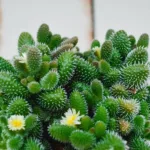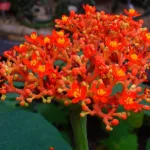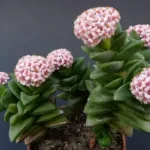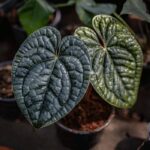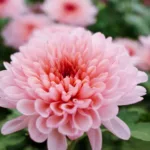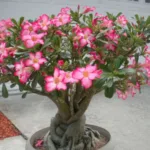Introduction
The Dollar Plant, also known by its scientific name Plectranthus nummularius, is a succulent of great popularity in landscaping and gardening due to its distinctive appearance and ease of cultivation.
The Dollar Plant is native to the arid regions of South Africa and is prized for its rounded, fleshy and shiny leaves, which resemble coins. Its thick, branched stem adds a sculptural touch, making it an ideal choice for both indoor pots and outdoor gardens. The Dollar Plant has a unique ability to store water in its leaves, which allows it to survive in drought conditions and makes its care relatively simple, even for novice gardeners.
table of contents
Meaning
In addition to its aesthetic beauty, the Dollar Plant carries a symbolic meaning. It is often associated with prosperity, growth and good financial luck. In some cultures, it is believed that having a Dollar Plant in the home or workplace can attract prosperity and wealth. The resemblance of the leaves to coins also contributes to this association. The Dollar Plant is a popular gift on occasions such as business openings, new homes or career changes, symbolizing good wishes for success and fortune in the future.
If you’re looking for a plant that not only enriches the aesthetics of your space, but also brings a touch of positive symbolism, the Dollar Plant is a versatile and meaningful choice. With its easy growth and striking appearance, it is a welcome addition to any plant collection.
| Common Name | Dollar Plant |
| Botanical Name | Plectranthus nummularius |
| Family | Crassulaceae |
| Plant Type | Succulent |
| Adult size | Usually reaches 1 to 1.5 meters |
| Sun exposure | Full sun to half shade |
| Soil type | Well-drained and sandy |
| soil pH | Slightly acidic to neutral (6.0 to 7.0) |
| Flowering Season | Winter to spring |
| Flower color | White, pink or red |
| Native Area | South Africa |
| Toxicity | Slightly toxic to humans and animals |
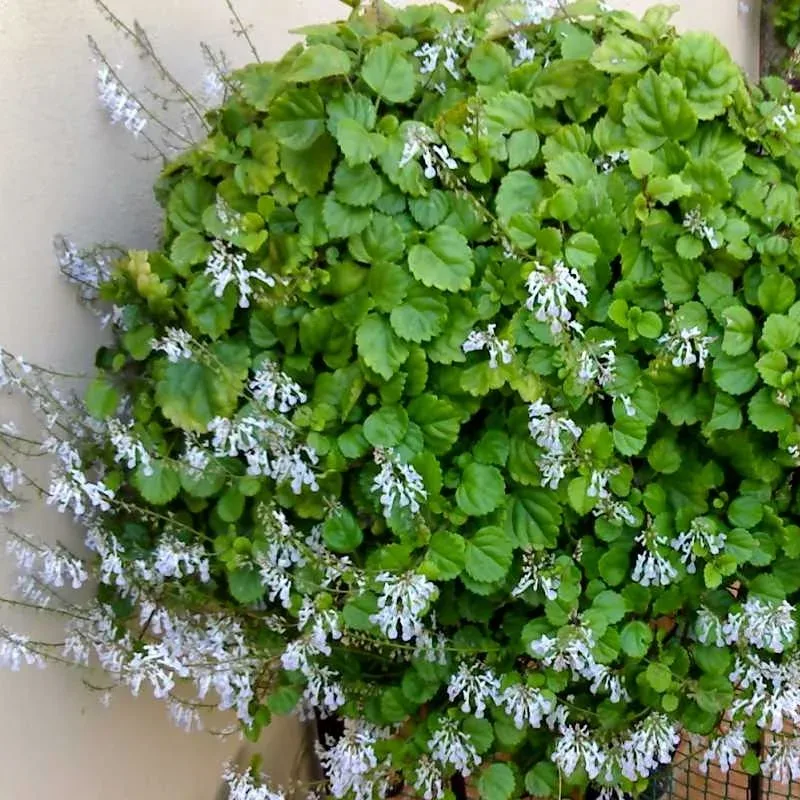
Dollar Plant Care
It’s a lovely succulent and easy to care for, but in order for it to thrive and show off all its beauty, it’s important to provide it with the ideal conditions. Here are the main aspects to consider when caring for this plant:
Light
The Dollar Plant’s light requirements are crucial for its healthy growth. Here are some tips on proper sun exposure:
- Bright Indirect Light: Place your Dollar Plant in a location with bright indirect light. Avoid intense direct sunlight, as it can cause burns on the leaves.
- Shade: If you’re growing your Dollar Plant outdoors, it can tolerate some direct sunlight, but it’s best to protect it with shade during the hottest hours of the day.
Soil
The right soil is essential for the Dollar Plant’s roots to develop healthily:
- Well-drained soil: Use a substrate for succulents or cacti that offers good drainage. This prevents water from accumulating around the roots.
Water
Although succulents are known for their resistance to drought, the Dollar Plant still needs careful watering:
- Moderate Watering: Water the plant when the soil is dry to the touch, but avoid waterlogging.
- Avoid Excess: Avoid leaving the plant in standing water, as this can lead to root rot.
Temperature and humidity
Maintaining the right temperature and humidity is essential for the Dollar Plant’s well-being:
- Moderate Temperature: It prefers temperatures between 18°C and 24°C, but can tolerate moderate variations.
- Low humidity: The Dollar Plant is adapted to arid climates, so avoid excessively humid environments.
Fertilizing
Correct fertilization contributes to the growth and general health of the Dollar Plant:
- Light fertilization: Fertilize during spring and summer with a balanced fertilizer for succulents.
- Frequency: Every 4-6 weeks is sufficient to provide the necessary nutrients.
By following these care guidelines, you will be providing a favorable environment for the Dollar Plant to thrive and adorn your space with its coin-shaped leaves and succulent charm.
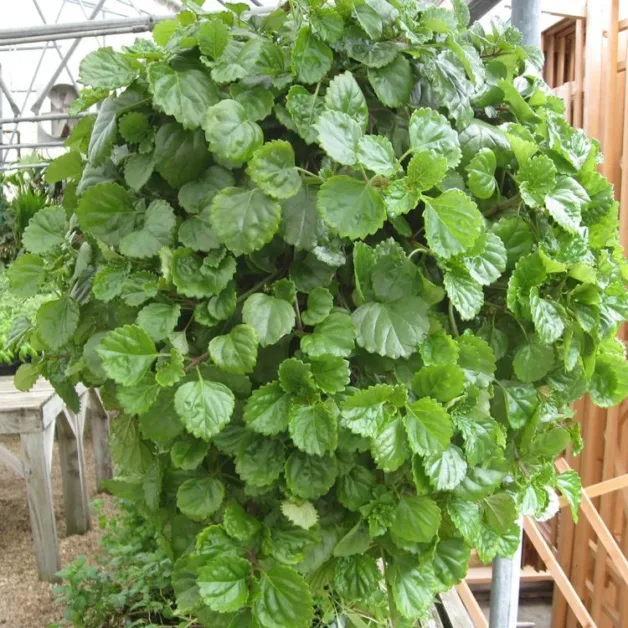
What Types of Dollar Plant
The Dollar Plant (Plectranthus nummularius) comes in a variety of types and cultivars, each with its own unique characteristics. If you’re interested in expanding your succulent collection, here are some of the most popular types of Dollar Plant:
1. Green Leaf Dollar Plant
This is the classic form of the Dollar Plant, with oval, fleshy leaves of a vibrant green. It’s a versatile and easy-to-care-for type, perfect for beginners and plant collectors.
2. Red-bordered Dollar Plant
This variety has green leaves with reddish or pink edges, adding a touch of color and visual contrast to your succulents.
3. Variegated Leaf Dollar Plant
Variegated leaves display different color patterns, such as white, cream or yellow, mixed with green. This variation adds an interesting decorative element to the plant.
4. Single Stem Dollar Plant
While the Dollar Plant usually branches out, some types have a single, sturdy stem that grows vertically, creating an elegant and imposing look.
5. Compact Dollar Plant
This variety tends to be more compact, with leaves closer together on the stem. It’s great for smaller spaces and succulent arrangements.
6. Pendant Dollar Plant
Some types of Dollar Plant have a pendulous growth, making them ideal for hanging pots or baskets.
7. Abundant Flowering Dollar Plant
As well as beautiful leaves, some cultivars produce small, delicate flowers that appear during the flowering season, adding an extra touch of beauty to your space.
These are just a few examples of the exciting types that the Dollar Plant offers. Each variety has its own visual and growing characteristics, allowing you to choose the ones that best fit your style and environment.
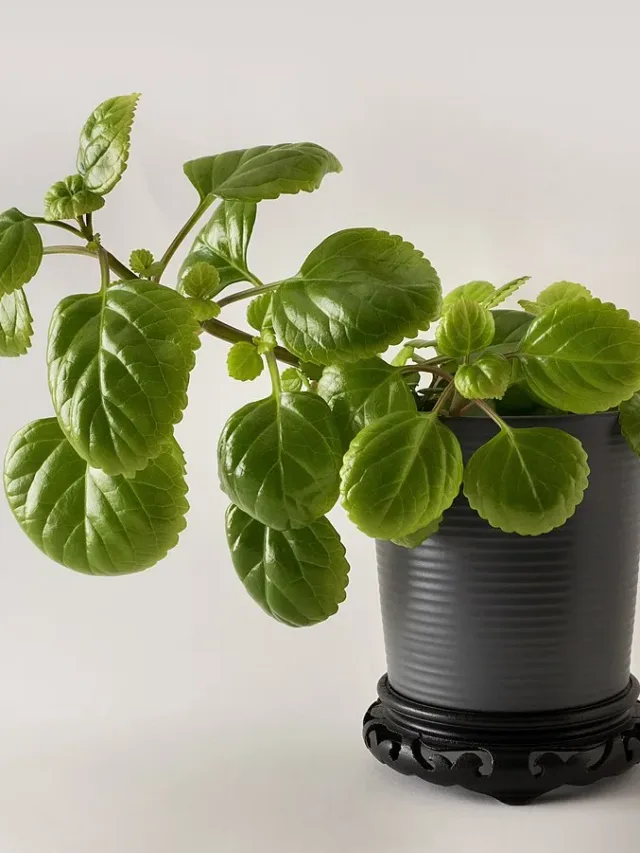
How to Prune the Dollar Plant: Importance and Techniques
Pruning plays a crucial role in the care of the Dollar Plant (Plectranthus nummularius), contributing to its healthy growth, desired shape and stimulating flowering. Here, we explore the importance of pruning and some essential techniques:
Importance of Pruning
- Stimulates Growth: By pruning the tips of the stems, you encourage lateral growth, resulting in a fuller, more exuberant plant.
- Promotes Flowering: Pruning removes wilted flowers and stimulates the emergence of new flowers, prolonging the flowering period.
- Maintains Shape: The Dollar Plant can become unkempt over time. Pruning helps maintain a more compact and attractive shape.
- Prevents elongation: If the Dollar Plant doesn’t get enough light, it can elongate its stems. Pruning helps control excessive growth.
Pruning techniques
- Stem tip pruning: Cut off the tips of the stems to encourage lateral growth. Use sharp scissors and make clean cuts.
- Removing wilted leaves: Remove wilted or damaged leaves to improve the plant’s appearance.
- Pruning Wilted Flowers: After flowering, cut off wilted flowers to promote new blooms.
How to make Dollar Plant seedlings
Propagation is an exciting way to grow new plants from the ones you already have. Here are two common methods:
- Leaf Cuttings:
- Choose a healthy leaf and carefully remove it from the mother plant.
- Let the leaf heal for a few days to avoid infection.
- Plant the leaf in soil for succulents, keeping it slightly moist.
- Wait for roots to develop and for new growth.
- Cut stems:
- Cut a healthy stem at an angle of about 45 degrees.
- Let the cut heal for a few days.
- Plant the cut stem in moist soil, burying about 1/3 of the stem.
- Keep the soil moist until the roots develop.
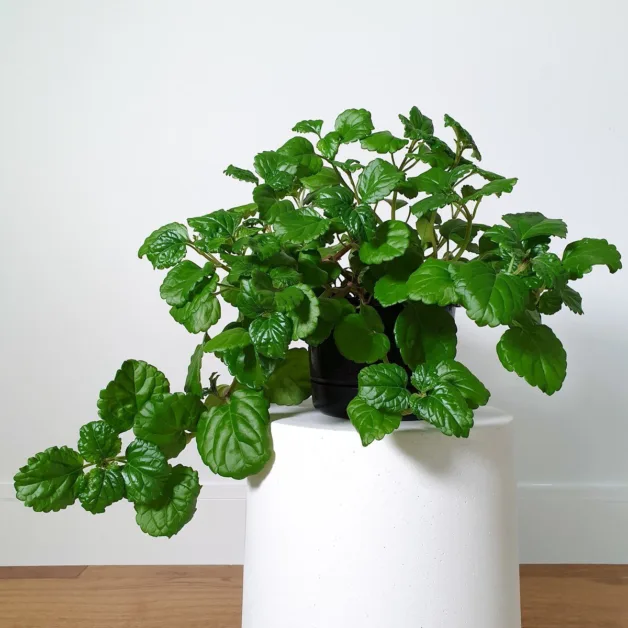
Step by Step on How to Plant the Dollar Plant
- Choosing a pot: Select a pot with good drainage and the right size for the number of plants.
- Soil preparation: Use succulent soil or a well-drained homemade mix.
- Pruning: If the plant is worn out, prune lightly to stimulate growth.
- Planting: Plant the cuttings or stems into the soil, pressing lightly.
- Initial watering: Water gently after planting, avoiding waterlogging.
- Maintenance: Place the plant in bright indirect light and water as needed.
- Ongoing Care: Keep pruning to maintain shape and stimulate growth.
By mastering the art of pruning and propagating the Dollar Plant, you can create a thriving and vibrant collection of this iconic succulent. Remember to adapt the care to the specific needs of the plant and the environment.
Most common pests and diseases
Just like any plant, Plectranthus nummularius can be subject to pests and diseases. Knowing the most common problems can help you identify and treat them in time. Here are some pests and diseases that can affect the Dollar Plant:
- Mealybugs: Small insects that feed on the plant’s sap. They can be found on leaves and stems.
- Mites: Microscopic pests that suck the sap, causing spots and discoloration on the leaves.
- Root rot: Usually caused by waterlogged soil, results in brown, rotten roots.
- Leaf spots: Dark spots or white patches on the leaves, often due to excess moisture.
- Powdery mildew: A white or gray mold that covers the leaves, usually occurring in humid conditions.
Common Problems and Their Solutions
When facing problems with your plant, here are some solutions to consider:
- Mealybugs: Use a damp cloth to remove them by hand. If the infestation is severe, consider using a suitable insecticide.
- Mites: Wash the leaves with water to remove them. Increasing the humidity around the plant can also help.
- Root rot: Remove the plant from waterlogged soil, cut off the affected roots and replant in dry soil.
- Leaf spot: Improve ventilation, avoid wetting the leaves and apply fungicide if necessary.
- Powdery mildew: Remove affected areas and increase air circulation around the plant. Use a fungicide if the infestation persists.
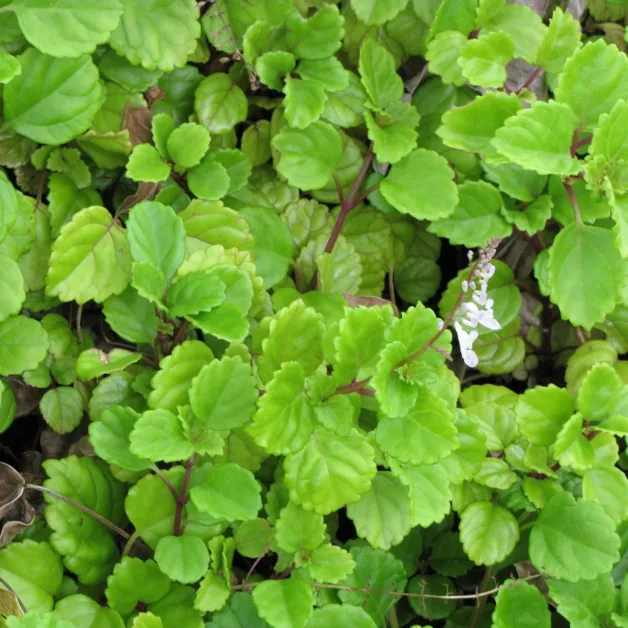
Advanced Care and Maintenance Tips
To take your Dollar Plant care to the next level and ensure its continued flowering, consider these tips:
- Plant Rotation: Rotate the pot periodically to ensure even growth.
- Strategic Pruning: In addition to maintenance pruning, carry out strategic pruning to shape the plant to your liking.
- Repotting: Transplant the Dollar Plant every 2-3 years to ensure space for the roots to grow.
- Winter dormancy: In colder climates, the plant may enter a period of dormancy. Reduce watering during this period.
- Regular observation: Monitor the plant regularly to detect problems early and take action.
By mastering the prevention, identification and resolution of problems, along with advanced care, you will create an ideal environment for your plant’s exuberant growth. Remember that each plant is unique, so adjust the care according to its specific needs.
Curiosities and myths
The Dollar Plant (Plectranthus nummularius) is much more than just a pretty succulent. It carries with it a number of curiosities and myths that add an intriguing touch to its story. Let’s explore some interesting facts and dispel some common myths:
Curiosities about the Dollar Plant
- African origin: It is native to the arid regions of South Africa and Mozambique.
- Longevity: With proper care, the Dollar Plant can live for decades, making it a long-lasting companion.
- Delicate flowering: Its flowers are small, star-shaped and appear during winter and spring.
- Easy propagation: It is an ideal plant for propagation, allowing you to grow new seedlings from leaves or cuttings.
- Symbolism: As well as attracting prosperity, the Dollar Plant also symbolizes friendship and good luck.
Myths about the Dollar Plant
- Attracting Instant Money: Although the Dollar Plant is associated with prosperity, it doesn’t bring instant money. Its symbolism is more related to encouraging a prosperous mindset.
- Protection against the evil eye: Although some cultures attribute the plant with the power to ward off the evil eye, there is no scientific evidence to prove this.
The Dollar Plant is much more than just a decoration. Its history rich in symbolism and its unique characteristics make it an intriguing and meaningful plant for many gardeners and succulent lovers. Whether you appreciate its aesthetic beauty or believe in its symbolism, the Dollar Plant continues to enchant and inspire.
Conclusion
Throughout this guide, we have explored in depth the world of the Dollar Plant (Plectranthus nummularius) – a succulent remarkable for its beauty, symbolism and ease of cultivation. Starting with its introduction, we learn about its distinctive features, such as its rounded leaves that resemble coins. We explore its variety of types, from green-leaved to variegated and colored-edge varieties, showing that there is a Dollar Plant for every taste and gardening style.
We then delve into essential care, from the right light to the correct fertilization. With information on pruning, propagation and troubleshooting, you are now equipped with the knowledge you need to successfully grow and care for this succulent. Remember that, like any plant, the Dollar Plant can have its quirks, so keep an eye on its individual needs. In the end, you’ll not only appreciate its unique beauty, but you’ll also be able to share your knowledge of the many aspects of this intriguing plant with other gardening enthusiasts.
Frequently Asked Questions
How do I care for the potted dollar plant?
To care for the potted dollar plant, follow these tips:
1.Choose a pot with good drainage.
2.Use soil for succulents or cacti.
3.Place it in bright indirect light.
4.Water when the soil is dry to the touch.
5.Avoid soaking the soil.
How do I prune a dollar plant?
To prune the dollar plant:
1.Cut off the tips of the stems to encourage lateral growth.
2.Remove wilted flowers after flowering.
3.Remove damaged or wilted leaves.
What is the dollar plant used for?
The dollar plant is grown mainly for its beauty and symbolism of prosperity. It can also be used for
1.Decorating interiors and exteriors.
2.Adding an exotic touch to succulent arrangements.
3.Propagating new plants from cuttings.
Where does the dollar plant like to stay?
The dollar plant likes to grow in places with:
1.Bright indirect light in full sun.
2.Temperatures between 18°C and 24°C.
3.Well-drained soil.
How do I look after a dollar plant?
To care for a dollar plant, remember to:
1.Water when the soil is dry.
2.Avoid waterlogging the soil.
3.Provide adequate light.
4.Do maintenance pruning.
5.Fertilize during the growing season.



